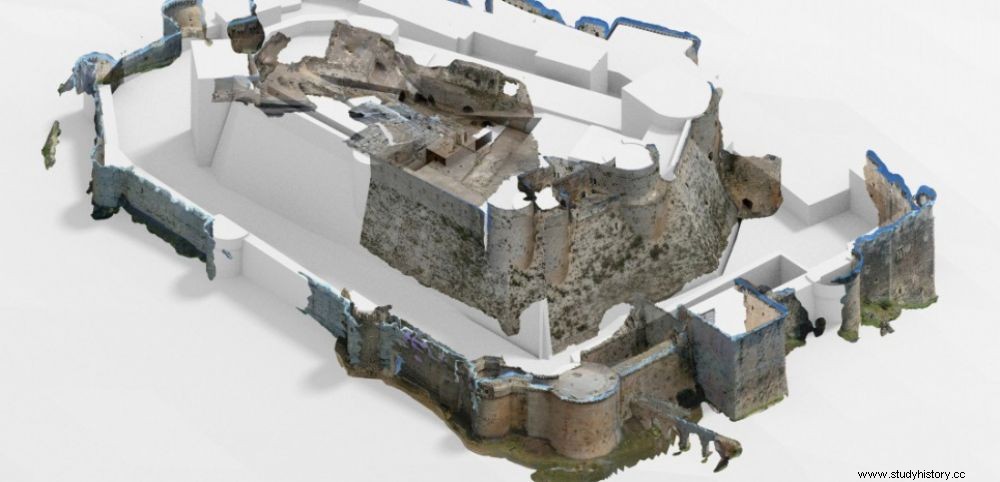 3D reconstruction in progress of Krak des Chevaliers, Syria.
3D reconstruction in progress of Krak des Chevaliers, Syria. HERITAGE. Will it all be gone forever? Or should one attempt to record in every way possible what can be? With the aim of preserving virtual archives of cultural heritage sites under threat, following the destruction by Daesh* of Syrian and Iraqi pre-Islamic treasures (including Nimrud, in Iraq, or more recently the temples of Bel, Baalshamin or the funerary towers of Palmyre, in Syria), the French Minister of Culture, Fleur Pellerin, launched the idea of a 3D reconstruction project of the Palmyre site on Friday, September 11.
In an interview published in the daily Liberation , the Minister explains that this undertaking "must be based on international collaboration" with the collection of data from the general public, i.e. the constitution of image banks from the photographs of researchers, travelers or any other person who has visited these places in the past. Evoking the example of the generous contribution of the French during the "Great Collection" carried out for the Centenary of the First World War. The Ministry of Culture has indeed decided to support projects by researchers wishing to use the technological developments of 3D to constitute a memory of the monuments that have disappeared.
Low-cost cameras to capture as many images as possible at ancient sites
In England, archaeologists from the universities of Oxford and Harvard (United States) associated in a joint venture, The Institute for Digital Archaeology, have already reported on similar projects several weeks ago. The idea is to distribute low-cost 3D cameras to local partners -museum staff, NGO members, or any volunteer- using which images of all ancient sites, heritage monuments, temples, exhibits in museums, reserves, etc would be captured . The stated objective is to recover one million 3D images (The Million Images Database Project ) by the end of 2016. Currently being manufactured, 5,000 of these devices, at a cost of less than 30 euros, should be ready by the end of December, beginning of January 2016 at the latest, according to Alexys Karenowska, one of the designers of the 'device. The images taken would then be transferred directly to an online database. For the implementation of this project, the institution would have received funding of 3.1 million dollars.
In March 2015, the Mosul project was one of the first to offer technologies calling on Internet users to "reconstruct" in 3D several of the works of art destroyed in the Mosul museum (Iraq), and thus create a virtual museum from photos taken before the establishment closed in 2003
In France, some young companies at the forefront of these fields have not waited for institutional decisions to take action. Thus the start-up Iconem uses these technologies for the 3D reconstruction of the Krak des Chevaliers. The medieval fortress, located in western Syria, was also a victim of Daesh attacks in 2014. "We want to show that it is already possible, with what is currently available, to carry out high-precision 3D reconstructions" , explains Yves Ubelmann, its founder.
The example of the Krak des Chevaliers fortress
It was thus possible to reconstruct a 3D model of a large part of the fortress by retrieving thousands of images from the Internet of the famous military building occupied by the Knights of the Hospital (12th-13th centuries) at the time of the Crusades, and thanks to photogrammetric models specially developed by the IT department of the ENS (Ecole Normale Supérieure), to which have been added images recently taken inside the battered building by Syrian archaeologists. "You can clearly see the detail of the destruction" adds Syrian archaeologist Houmam Saad (ENS) who is collaborating on the project. Important testimonials that can be accessed online by curators and managers in charge of heritage. This process will be applied to other monuments shortly.
Below are some illustrations of this ongoing project.

3D reconstructions of facades of the Krak des Chevaliers (Syria), before and after the destruction of 2014. In red, the destroyed parts. © ICONEM
"Nothing will ever replace these destroyed treasures. But we have the choice between nothingness and these reconstructions" , concluded Fleur Pellerin, whose examination of the Freedom of creation, architecture and heritage bill, adopted by the Council of Ministers on July 8, 2015, should soon be examined in Parliament.
*Daesh:Arabic acronym for ISIS (Islamic State)
